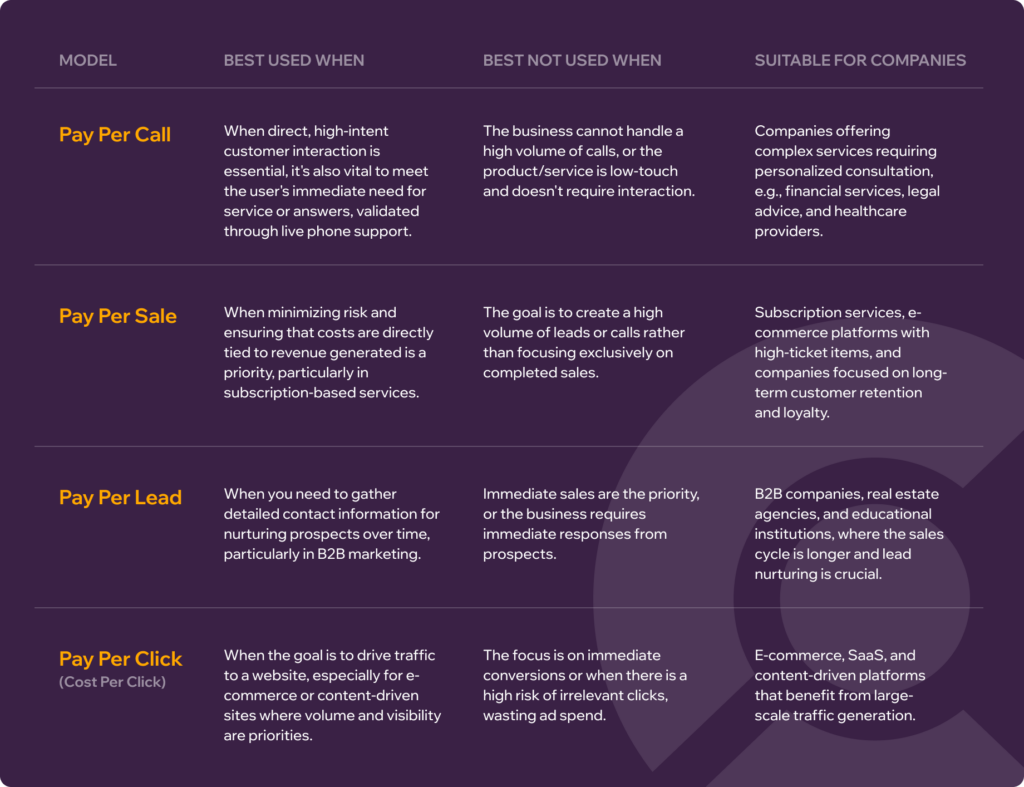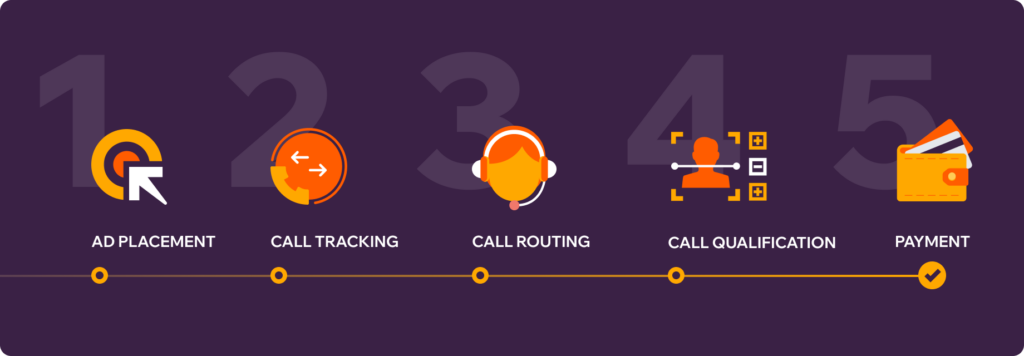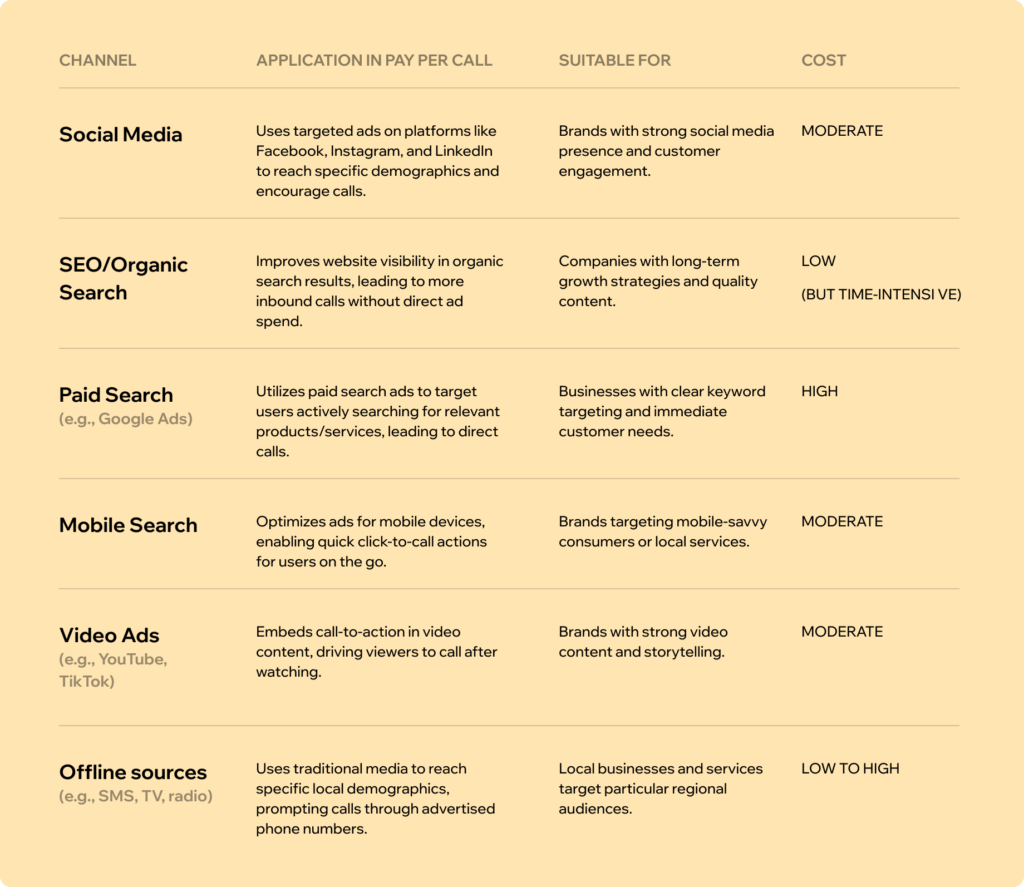Pay-per-call marketing is a performance marketing strategy that allows businesses to be compensated only after they receive an inbound call from potential customers.
This model is appropriate in industries where buyers want to communicate with people interested in their products, such as debt relief or ACA services.
Pay Per Call vs. Other Marketing Strategies
In performance-based marketing, several models offer businesses unique ways to pay for and measure their advertising efforts. Each model has strengths and best-use scenarios, which can significantly impact a campaign’s effectiveness.
Marketing Models: A Comparative Overview
Several models are used in performance-based marketing. They provide businesspersons with different approaches to paying for their adverts and, in return, assessing their effectiveness. Every model has its pros and cons or is suitable for specific circumstances, which influences the efficacy of a campaign.

Pay-Per-Call occupies a special place among the most effective methods of obtaining leads. It provides a direct and more specific type of interaction that considerably raises conversion levels. That is why it is a very useful instrument for any marketer, as it directly links businesses to customers willing to make a purchase.
Best Verticals for Pay-Per-Call
Pay-per-call marketing can be especially beneficial when client engagement is central, such as the ACA (Affordable Care Act), health insurance, debt relief, and home repair services.
ACA
Engaging consumers during the open enrollment periods, which are November to December, cannot be overemphasized in the ACA market. It is at this stage that potential customers initiate the search for health insurance plans and thus stand a higher chance of being converted when they call. This means that pay-per-call campaigns can take advantage of high-intent leads in this vertical to ensure the advertising spend is well directed.
Debt Relief
The utilization level is high, and the trends are further rising in the debt relief sector. This estimate was in the latest release by the Federal Reserve Bank of New York report that indicated that total household debt hit $17. 80 trillion in Q2 2024, $109 billion more than in the previous quarter. This steady increase in debt level points to the growing number of consumers that require its services. It can also be seen that pay-per-call campaigns can easily benefit and exploit this massive and growing market with those struggling to pay off their debts. Given these situations’ delicateness and the person-to-person type of communication, phone calls can be effective, and conversion rates are higher.

Home Repairing
A similar tendency is also characteristic of home improvement services, but the rates increase even more during summer. Pay-per-call can provide a consistent flow of quality leads in this vertical, particularly when campaigns are initiated well before a busy period to enable proper optimization.
Altogether, PPC marketing can be considered a solid platform for industries requiring the highest-quality and most relevant service and product leads. No matter it is ACA health insurance, debt relief, or home improvement, this model guarantees that businesses selling those products reach willing and ready consumers.
At LeadsCall, Pay Per Call is our core business
Contact UsWhat are the Benefits and Drawbacks of Pay-Per-Call Marketing?
Compared to other forms of advertising, pay-per-call marketing brings special benefits for businesses reaching an audience of customers with a high purchase intention, but it also has some peculiarities.
Pros of Pay Per Call
- High-Intent Leads
When potential customers are dialing the phone, they are most likely in the advanced stage already.
- Drives Only Qualified Calls
The pay-per-call campaigns are set in a way that requires advertisers to pay only for calls that meet specified quality standards.
- Maximize Your Brand’s Reach
Due to narrow consumer targeting in the upper or middle part of the marketing funnel, the strategy can reach users without a preferred brand, making it more recognizable.
- Increased ROI
While being more expensive per lead, pay-per-call campaigns deliver higher conversion rates, which may compensate for the difference in cost.
- Measurable Results
Optimization techniques help businesses track the effectiveness of their ad campaigns in real-time.
- Convenient Lead Handling
Technological protocols, such as IVR systems and call routing, ensure that leads are connected to the right sales agents.
- Enhanced Customer Insights
First-hand interaction with customers during a call provides relevant information on their requirements, choices, and concerns.
- Immediate Feedback
Compared to others, phone calls provide almost instant feedback to the business making it easier for them to change or improve the campaign to suit the markets.
- Predictable Call Volume and Budget
Limiting the number of calls one requires can be useful, especially since it can help manage resources well.
- Profitable Method
Phone calls usually work better than other sorts of models, so businesses will experience higher revenues and improved long-run customer loyalty.
- Access to Call Generation Experts
Employing the services of established pay-per-call marketers helps businesses tap into professional expertise and techniques, achieving high optimization rates.
- Increased Accessibility
This model opens up opportunities for customers who prefer direct communication or have limited access to digital channels and simplifies tracking. With users dialing a phone number directly from the ad, every call reaches its intended target, ensuring higher profitability compared to traditional CPL or CPA tracking methods.
Cons of Pay Per Call
- Resource-Intensive Management
By nature, Pay-Per-Call campaigns require constant scrutiny and evaluation of the outcomes, which consumes considerable time in the initial phases.
- Dependency on Call Handling Quality
The effectiveness of a Pay-Per-Call campaign heavily relies on the quality of the team handling the calls; poor performance can result in lost opportunities.
How Does Pay Per Call Marketing Work?
Pay-Per-Call marketing directly connects the goals of the advertiser with the needs of the consumer, which means that businesses only pay for a direct sales call to genuine and qualified prospects. Here’s a closer look at the mechanics behind Pay Per Call:

Ad Placement
This involves placing ads and creating them via a publisher across a channel that may include search engines, social media, and others. Such ads commonly contain a clickable link or tagline prompting potential customers to call a specific number used in the ad.
Call Tracking
Every placed ad has its number, which helps in tracking results. This makes it possible to see where the calls originate and relate them to particular campaigns. The tracking system also captures the actual call and other information, such as the caller’s location and time.
Call Routing
When a user comes across the ad and wishes to call the displayed number, the call automatically connects to the business or a hired call center. This guarantees the customers are linked to the right office to get their concerns addressed.
Call Qualification
Note that every call doesn’t necessarily constitute a billable occasion. Purchasers would identify parameters for a paid call, including the call’s minimum length, the caller’s geographic location, or a substantial discussion of the product or service.
Payment
The buyer is charged for that call after a call has been established and meets all the requirements described in a call profile. This means that the advertiser pays only for real calls that can potentially lead to sales, making it one of the most effective models for lead generation.
Marketing Channels for Pay-Per-Call Campaigns
While developing your Pay-Per-Call campaign, you should consider the marketing channels accepted by the buyer. There are cases when the publisher works with a limited number of channels. To be effective, try to concentrate the effort on media that you and the buyer can manage well.

To Sum Up
Pay Per Call should not only be a question of strategy but also of applying the advantages of a specialized team. Due to the ease of tracking, PPC remains an effective channel, especially as we transition to a world without third-party cookies. Google Chrome’s decision to end third-party cookie support by late 2024 will greatly affect companies that rely on this tool for advertising.
Nevertheless, Pay-per-Call is immune to this problem because it utilizes phone numbers, making it a progressive and future-oriented concept in the modern digital world. To be successful in PPC, constant optimization, communication, and management of the call sources must be used to create a high-quality and impactful environment. At LeadsCall, Pay Per Call is our core business. We deliver results with a client-centered approach, transparency, and reliability.



